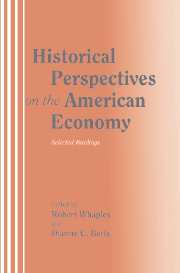Book contents
- Frontmatter
- Contents
- Acknowledgments
- Introduction to students
- Introduction to instructors
- Contributors
- I Introduction
- II Colonial and early national economy
- III Slavery and servitude
- IV The South since the Civil War
- V The rise of American industrial might
- VI Populism
- 15 “A reappraisal of the causes of farm protest in the United States, 1870–1900”
- 16 “The ‘Wizard of Oz’ as a monetary allegory”
- VII Women in the economy
- VIII The Great Depression
- Appendix: Basics of regression
- Glossary
- Name index
- Subject index
16 - “The ‘Wizard of Oz’ as a monetary allegory”
Published online by Cambridge University Press: 05 June 2012
- Frontmatter
- Contents
- Acknowledgments
- Introduction to students
- Introduction to instructors
- Contributors
- I Introduction
- II Colonial and early national economy
- III Slavery and servitude
- IV The South since the Civil War
- V The rise of American industrial might
- VI Populism
- 15 “A reappraisal of the causes of farm protest in the United States, 1870–1900”
- 16 “The ‘Wizard of Oz’ as a monetary allegory”
- VII Women in the economy
- VIII The Great Depression
- Appendix: Basics of regression
- Glossary
- Name index
- Subject index
Summary
The Wonderful Wizard of Oz, perhaps America's favorite children's story, is also an informed comment on the battle over free silver in the 1890s. The characters in the story represent real figures such as William Jennings Bryan. This paper interprets the allegory for economists and economic historians, illuminating a number of elements left unexplained by critics concerned with the politics of the allegory. It also reexamines Bryan and the case for free silver. Far from being monetary cranks, the advocates of free silver had a strong argument on both theoretical and empirical grounds.
Introduction
The Wizard of Oz is perhaps the best-loved American children's story. The movie, starring Judy Garland, Bert Lahr, Ray Bolger, and company, is an annual television ritual. The book on which the movie is based, L. Frank Baum's The Wonderful Wizard of Oz, however, is not only a child's tale but also a sophisticated commentary on the political and economic debates of the Populist Era. Previous interpretations have focused on the political and social aspects of the allegory. The most important of these is Littlefield ({1966} 1968), although his interpretation was adumbrated by Nye (1951), Gardner and Nye (1957), Sackett (I960), and Bewley ([1964] 1970). My purpose is to unlock the references in the Wizard of Oz to the monetary debates of the 1890s.
- Type
- Chapter
- Information
- Historical Perspectives on the American EconomySelected Readings, pp. 524 - 546Publisher: Cambridge University PressPrint publication year: 1995
- 1
- Cited by



